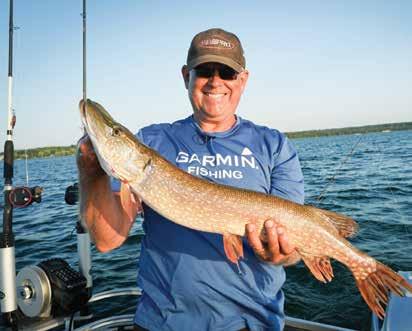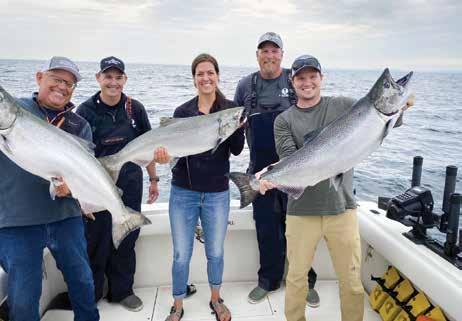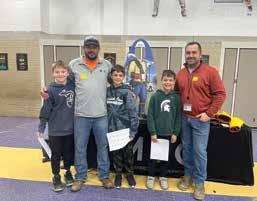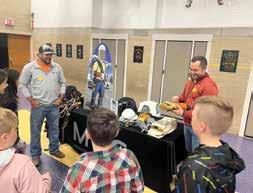COUNTRY LINES



Many homeowners have come to accept that a noisy A/C is a fact of life. But with WaterFurnace, you don’t have to settle.
Nothing can disrupt a perfect summer afternoon in your backyard more than a loud air conditioner. Geothermal users are never disturbed from outside HVAC noise because there’s no outdoor equipment to make any. All the complicated work takes place underground—out of earshot. With WaterFurnace, your peace and quiet is assured. To learn more, contact your local WaterFurnace dealer today.
Geothermal is the only renewable that provides reliable operation 24 hours a day, 7 days a week, 365 days a year.
Allendale Allendale Htg & Clg (800)327-1937
allendaleheating.com
Bad Axe/Ubly
Cutting Edge Htg & Clg (989)551-0986
Berrien Springs
Waterfurnace Michiana (269)473-5667
gogreenmichgeo thermal.com
Big Rapids Stratz Htg & Clg, Inc. (231)796-3717
stratzgeocomfort.com

Clifford Orton Refrig & Htg (989)761-7691
sanduskygeothermal.com
Hart Adams Htg & Clg (231)873-2665
adamsheating cooling.com
Indian River M&M Plmb & Htg (231)238-7201 mm-plumbing.com
Lansing Candor Mechanical (517)920-0890 candormechanical.com
Lowell Arctic Inc. Htg. & Clg. (616)897-4213 heatingcoolingonline.com
Mancelona
Top Notch Htg, Clg, & Geothermal (231)350-8052

Topnotchheatandair.com
Michigan Center Comfort 1/Air Serv of Southern Michigan (517)764-1500 airserv.com/southernmichigan/
Mt Pleasant Walton Htg & Clg (989)772-4822 waltonheating.com
Muskegon Adams Htg & Clg (231)873-2665 adamsheatingcooling.co Portland ESI Htg & Clg (517)647-6906 esiheating.com
Sunfield Mark Woodman Plmb & Htg (517)886-1138 mwphonline.com
Traverse City D&W Mechanical (231)941-1251 dwmechanical.com
Geofurnace Htg & Clg (231)943-1000 geofurnace.com
Cloverland: up to $4,200
Great Lakes: up to $3,000
Homeworks/Tri-County: up to $3,000
Presque Isle: up to $2,700
Cherryland: up to $2,500
Thumb Electric: up to $2,000
Alger Delta: up to $2,000

XECUTIVE EDITOR: Casey Clark
EDITOR: Christine Dorr
GRAPHIC DESIGNER: Karreen Bird
RECIPE EDITOR: Christin McKamey
COPY EDITOR: Yvette Pecha
CONTRIBUTING EDITOR: Emily Haines Lloyd
PUBLISHER: Michigan Electric Cooperative Association
Michigan Country Lines, USPS-591-710, is published monthly, except August and December, with periodicals postage paid at Lansing, Mich., and additional offices. It is the official publication of the Michigan Electric Cooperative Association, 201 Townsend St., Suite 900, Lansing, MI 48933.
Subscriptions are authorized for members of Alger Delta, Cherryland, Great Lakes, HomeWorks Tri-County, Midwest Energy & Communications, Ontonagon, Presque Isle, and Thumb electric cooperatives by their boards of directors.
Postmaster: Send all UAA to CFS.
Association Officers: Tom Sobeck, Presque Isle Electric & Gas Co-op, chairman; Gabe Schneider, Cherryland Electric Cooperative, vice chairman; Chris O’Neill, HomeWorks TriCounty Cooperative, secretary-treasurer; Craig Borr, president and CEO.
CONTACT US/LETTERS TO EDITOR: Michigan Country Lines 201 Townsend St., Suite 900 Lansing, MI 48933 248-534-7358 editor@countrylines.com

CHANGE OF ADDRESS: Please notify your electric cooperative. See page 4 for contact information.
The appearance of advertising does not constitute an endorsement of the products or services advertised.
/michigancountrylines /michigancountrylines countrylines.com
#micoopcommunity Instagram contest winner
It's beginning to look like spring in Michigan! @sarah-smith.180 (Sarah Smith)
6 PLAN YOUR NEXT VACATION WITH THE GREAT LAKES FISHERMAN'S DIGEST This TV show/website/trade show exhibit is a one-stop shop for those who want to go where the fish are biting.
10 MY CO-OP KITCHEN Polish: The flavors of Poland straight to your kitchen.
14 MORE MILK: THE MICHIGAN DAIRY INDUSTRY'S COMMITMENT TO COMMUNITY
The unique relationship between Michigan farmers and their cows makes our state the sixth-highest milk producer in the country.
18 GUEST COLUMN Spring Gardening: The rich tradition of her family's garden preparation is one of this GLE member's fondest memories.

To enter contests, submit reader content, & more, visit countrylines.com/community

Instagram Contest
Use #micoopcommunity for a chance to be featured here and on our Instagram account. Win $100 for photos published!
Recipe Contest
See details on page 10. Chocolate due July 1. Win a $100 bill credit!
Guest Column
Share your fondest memories and stories. Win $200 for stories published. Visit countrylines.com/community to submit. Win $200 for stories published!
teammidwest.com
CORPORATE HEADQUARTERS AND CASSOPOLIS SOLUTIONS CENTER
60590 Decatur Road, Cassopolis, MI 49031
M–F 8 a.m.–5 p.m.
PAW PAW SOLUTIONS CENTER
59825 S. LaGrave Street, Paw Paw, MI 49079
M–F 8 a.m.–5 p.m.
Tecumseh Solutions Center 5050 South Occidental Hwy., Tecumseh, MI 49286
M–F 8 a.m.–5 p.m.
CONTACT US
Midwest Energy & Communications 800-492-5989 teammidwest.com
Email: info@teammidwest.com
BOARD OF DIRECTORS
Clarence “Topper” Barth, Chairperson, Three Rivers 269-279-9233
Clarence.Barth@teammidwest.com
Ben Russell, Vice Chairperson, Constantine 269-506-1590
Ben.Russell@teammidwest.com
Ron Armstrong, Secretary, Lawton 269-299-0443
Ron.Armstrong@teammidwest.com
John Green, Treasurer, Dowagiac 269-470-2816
John.Green@teammidwest.com
Dan Bodette, Wauseon 419-337-8007
Dan.Bodette@teammidwest.com
Gerry Bundle, Cassopolis 269-414-0164
Gerry.Bundle@teammidwest.com
Erika Escue-Cadieux, Onsted 419-346-1088
erika.escue-cadieux@teammidwest.com
Fred Turk, Decatur 269-423-7762
Fred.Turk@teammidwest.com
Jim Wiseley, Bloomingdale 269-760-4619
Jim.Wiseley@teammidwest.com
PRESIDENT/CEO: Robert Hance

DIRECTOR, CORPORATE COMMUNICATIONS & MARKETING: Amy Pales
COMMUNICATIONS SPECIALIST:
Grant Zamora
Midwest Energy & Communications is an equal opportunity provider and employer.
Please note: electric customers of MEC must adhere to our bylaws, which can be found at teammidwest.com/bylaws.
Over the last year, I’ve had a few columns about grid reliability and the potential for rolling blackouts due to supply not being able to meet demand. I continue to bring it up because it’s a critical issue that impacts us all.
The energy landscape is changing. We’re in the midst of a strong push to net-zero carbon emissions while increasing reliance on electricity through electric vehicles and other means.
As someone at the forefront of innovation several times throughout my career, I’m not afraid of change. However, the way this change is being implemented is the problem. The breakneck speed at which traditional power generation plants are being closed without adequate replacement has left our nation vulnerable. Renewables are a great addition to the nation’s fuel mix, but they are weather dependent. No sun or wind = no power, and as an industry, we don’t yet have battery capabilities that enable us to store renewable-generated electricity for later use. As a result, we’re essentially tearing down our old house before we’ve finished building the new one.
So, what can we do about this? Educate our legislators.
The National Rural Electric Cooperative Association (NRECA) serves 832 distribution cooperatives and 63 generation and transmission cooperatives, and acts as the voice for the 42 million electric cooperative customers we serve. The organization works hard every day to ensure policymakers understand the needs of rural residents while helping cooperatives engage with elected officials in their home states. The NRECA America’s Electric Cooperative PAC also supports political candidates and parties on both sides of the aisle to ensure co-ops have a seat at the proverbial political table.
Additionally, every April, the NRECA hosts a legislative conference where co-ops nationwide come together to meet with federal legislators on critical issues. MEC
has attended this conference for years; this year, electric reliability was a top agenda item. We met with the following legislators and/or their staff: U.S. Senate and House of Representatives Members Dingell, Walberg, Slotkin, Huizenga, and Bergman. We shared our concerns about electrifying the economy, disorderly retirement of traditional generation sources, permitting challenges, supply chain issues, and natural gas availability. We also discussed the upcoming Farm Bill and the need for continued financing for infrastructure upgrades, innovative energy programs, broadband projects, and the need to streamline permitting for infrastructure projects.
Like the NRECA, the Michigan Electric Cooperative Association (MECA) represents Michigan’s electric co-ops on regulatory and policy issues within Michigan and has been actively bringing awareness to grid reliability.
Finally, I’m no stranger to Washington D.C., having presented to Senate subcommittees, the U.S. Department Of Agriculture (USDA) Rural Utilities Service, the Federal Communications Commission, and numerous other national associations. In fact, one of my primary priorities is advocating for our rural customers and co-ops at all levels of government. I will continue to pursue opportunities for MEC to bring this issue to the forefront.
All this is to say that many voices are sharing their concerns about our ability to keep the lights on. You should do the same. The louder we speak, the sooner policymakers will listen. Visit teammidwest.com/advocacy to download a letter that you can mail to your representatives. We also provide information on how to find out who your elected officials are.
I also encourage you to visit teammidwest.com/reliability for more information on grid issues, the potential for rolling blackouts, and what we can do to try to avoid them when the grid is taxed.
The unfortunate truth, particularly during major storms, is that we don’t know. Estimating restoration times is an extremely tricky business. To show you why, we’ve put together a step-by-step explanation of the restoration process.
As soon as your power goes out, report it to us. Provide as many details as you can. Even if your neighbors have already called it in, submitting your own report helps us pinpoint where and what the issue is. Let us know about any fallen lines, but DO NOT approach them as they pose a potentially deadly threat.
If your meter base or equipment is damaged, an electrical inspection is required before we can restore service. You may need to contact a licensed electrician to make repairs.
Southwest Michigan inspectors: teammidwest.com/SWMI-inspectors
Southeast Michigan inspectors: teammidwest.com/SEMI-inspectors
Our crews respond to 911 calls for downed lines by de-energizing them. This is always our first priority. Dispatchers also begin sending crews to reported outages to determine the extent of the outage and the equipment needed for repairs.

Crews start with substations and major lines, working their way down to individual homes like yours. If you see trucks near your property and they leave before you’re restored, they’re
either continuing repairs further down the line, or they’re repairing a larger part of the outage before returning to your specific property.
Please do not approach our crews or ask them questions in the field. It’s dangerous for both you and them, and it delays restoration for everyone.
If you’ve signed up for outage notifications, we’ll send you a text or email when your power is restored. Visit teammidwest.com/outagenotifications to see how to sign up.
If you get a notification that your power is back on, but it is not, please rereport your outage. Your address may have been part of a larger outage
that was restored, but your specific issue remains. It's also possible the system automatically added your address to a separate outage.
The easiest and fastest way to report an outage is via your SmartHub mobile app. You can also call our automated reporting system at 800-492-5989.
Please do not report your outage by email or through social media, as we are not always immediately available.
Our offices will be closed Tuesday, July 4, in honor of Independence Day. Make a payment or report an outage via SmartHub or call 800-492-5989.
Dropbox payments made while we are closed will be processed on Wednesday, July 5. Have a safe and happy Fourth of July!

 By Yvette Pecha
By Yvette Pecha
or the many Michiganders who live and breathe for fishing, the Great Lakes Fisherman’s Digest could very well be the only resource you need. The Digest was started in 2015 by champion angler John Bergsma, who competed in tournaments for nearly 20 years. His goal for the digest was three-fold: to provide guidance to viewers/readers on where and when to fish, give instruction on how to catch the fish, and introduce people who love the outdoors to potential new vacation destinations. “I ultimately want to help people have a better experience on the water,” John said.
The Great Lakes Fisherman’s Digest is comprised of a television program of the same name, a website, and a portable display that John or his cohorts transport between several sporting trade shows. The TV show broadcasts on a weekly basis, rotating between Midwest regions on major market channels. John himself is in
many of the shows, but his partners also serve as hosts. Each show features a fishing segment and a spotlight on the town. “Our idea is simple: Identify the best locations for fi shing the Great Lakes and then highlight not only the fi shing, but the host community as well,” he said.
The website, in addition to airing the TV show, features fi shing reports and more detailed tourist information such as lodging, dining, recreation, shopping, and maps. The 60x10-foot travel center takes brochures, travel guides, and photos from each partner locale to the trade shows so that people can collect information from all destinations in one place.
The Digest also has an active Facebook page, with posts that are updated daily. “People visit our website or Facebook page to determine where they want to fi sh that same weekend—wherever the fi sh are biting drives people to destinations,”
John said. “They rely on our advice because of my tournament experience and because I only work with people I know and trust.” His Digest partners include bait store employees, fi shing guides, and charter captains—all local to the corresponding area.
John, who said he fishes about 120 to 140 times a year, tapes his excursions on most occasions, but some trips are just for pleasure. He is the rare man whose job also happens to be his passion. “The stress of life and anything that’s wrong just goes away on the water. You get an ever-changing canvas—from sunrise to sunset, clouds moving through, wind or no wind, birds on the water—you can just forget about everything,” he said.
John chose the Great Lakes region as the backdrop for his passion for a simple reason—“It’s the greatest single fishing destination in the world,” he said. “There are so many different species and types of fish
“Our idea is simple: Identify the best locations for fishing the Great Lakes and then highlight not only the fishing, but the host community as well.”

you can catch here, and because of ice fishing, you can fish every single day of the year. And in my opinion, it offers the three most desirable fish to eat: salmon, walleye, and perch.” The areas he advertises are generally chosen for two reasons—they have an abundance of fish and they’re some of his favorite spots. John says some of the best places for fishing are the most underutilized, so you won’t necessarily see hot vacation havens on the Digest. “I recommend that people pick a destination you haven’t gone to and spend three or four days there," he said. "Try new lakes and new adventure. Instead of saying ‘let’s just
drive an hour and go to the tourist trap we always go to,’ try somewhere you haven’t been. You’ll have a great time exploring.” John also recommends that people go on a charter fishing trip. “It’s a great deal for five or six hours on the water. You get to have a fun family excursion, and often, they’ll cook for you at the end whatever you catch. I think people who try it once will get hooked,” he said (no pun intended).

Watch the “Fisherman’s Digest” TV show.
Available locally and nationally on these networks and times (EST).
CBS Sports Network (Sat., 7:30 a.m., Jan.–June)
Pursuit Outdoor Channel (Sat., 4:30 p.m., Jan.–June & Wed., 6:30 p.m., Oct.–Dec.)



As for John, he’ll continue exploring as long as he’s healthy. “I can’t imagine a day that going out and exposing great destinations and fi shing will not be fun,” he said. For
WILD TV Canada (3 weekly airings. Prime/Fringe Prime/Off Peak, Jan.–June )
AT&T Sportsnet Southwest (Weekends between 9 a.m.–9 p.m., Jan.–June)
Comcast Sportsnet Chicago Plus (Mon., 12:30 p.m., Jan.–Dec.)
WKBD-50 Detroit & All Suburbs (Sat., 7:30 a.m.)
WBSF-46 Midland/Saginaw/ Bay City (Sun., 6 a.m.)
WOTV-4 Grand Rapids/ Kalamazoo (Sat., 11 a.m.)
Fox-32 Traverse City Northern Lower (Sun., 7:30 a.m.)
WBKB-11 NE Lower Alpena (CBS 11, Sat., 12 a.m.) (NBC-11, Sun., 5:30 a.m.) (Fox-11, Sat., 6 a.m.)
Fox-6 Marquette & U.P. (Sun., 8:30 a.m.)
Also available on YouTube, Facebook, Sling-Live, Hulu-Live, Pluto, Pursuit UP, and fishermansdigest.com
Wondering why your energy bill went up? Ask yourself—did you buy any new appliances or electronics lately?
Everything you buy that uses electricity has two price tags. The first is the one you’ll pay before you walk out the door, and it might be the only one you consider before making your purchase. The second, however, is just as important. It’s the energy cost, and you’ll pay it every time the appliance uses energy—sometimes even when it appears to be switched off, also known as a “vampire load.”
Nonessential appliances, like a second refrigerator or hot tub, can raise your electric bill significantly.
A second fridge can drive up your energy costs by more than $100 per year, according to Energy.gov, while the operating cost of a hot tub can be substantially more. Doing thorough research before you buy anything that uses energy can save you money.

According to the FTC, manufacturers are required to place a yellow EnergyGuide label on air conditioners (central, room, and portable),
boilers, ceiling fans, clothes washers, dishwashers, freezers, furnaces, heat pumps, pool heaters, refrigerators, televisions, and water heaters.
The label shows an energy use estimate based on the national average electric cost, as well as a comparison to other similar models.
For a more accurate estimate, or to estimate the cost of appliances that don’t have an EnergyGuide label, you can do some quick math. You'll need:
• Estimated number of hours you’ll use the appliance per day
• Estimated number of days you’ll use the appliance per year
• Appliance’s wattage
• Your current electric rate (check your bill)
Then find the following in order:
1. Daily kWh consumption: Multiply wattage by hours used per day, then divide by 1,000
2. Annual energy consumption: Multiply daily kWh consumption (step 1) by the number of days used per year
3. Annual estimated energy cost: Multiply annual energy consumption (step 2) by utility rate per kWh
Below is an example calculation based on an appliance that uses 1,000 watts.
Hours used per day: 2
Days used per year: 200
Wattage: 1,000
Example electric rate: $0.048597/kWh
Daily kWh consumption = (1,000 watts x 2 hours) ÷ 1,000 = 2
Annual energy consumption = 2 x 200 = 400
Annual estimated energy cost = 400 x 0.048597 = 19.4388 = app. $19.44 per year
Getting a new appliance isn’t an allor-nothing choice—you can still shop for what you want while being energy conscious. Energy.gov recommends looking for appliances with an ENERGY STAR® label. These meet strict efficiency requirements and can help you save on energy costs over other similar products. Check for the logo if you’re trying to find the most bang for your buck.
Smart appliances can be more expensive up front, but can shift their electricity use automatically. This includes using less energy during highdemand hours if you’re participating in our Time-of-Use program.
After a long winter, we finally made it. Summer is here! Get ready for beach days, neighborhood cookouts—and the “tap tap tap” of keyboards and game controllers.
Video games are one of the most popular ways for kids to spend their time. For parents, the games available today might seem confusing or even concerning—but with a bit of knowhow, it’s easy to keep your kids safe while letting them have fun. Here are some things parents should know, according to experts at PC Magazine and the Entertainment Software Ratings Board (ESRB).

Movie fans are probably familiar with the G, PG, PG-13, and R rating scales. The ESRB has similar ratings for games: The most common are E for Everyone, T for Teen, and M for Mature. There’s also Early Childhood (EC), Ages 10 and Up (E10), and Adults Only (AO).
If you buy a game in a store, it has an ESRB rating somewhere on the box. You can also search ratings online at esrb.org. Next to the letter rating, you’ll see a simple list of any content parents might find objectionable.
These ratings can be helpful, but they can also describe a wide range of content that differs from game to game. For example, “Fantasy Violence” can apply to many potential scenarios. It’s a good idea to do additional research beyond seeking out the ESRB rating.
Some games, like Roblox, let users create and upload their own game modes or other content, sort of like
how YouTube allows users to upload their own videos. This content isn’t always appropriate for children, and other users might not be people you want your kids interacting with.
Does this mean playing online is always dangerous? Of course not—but it always pays to research exactly what online capabilities a game might have. Additionally, many newer consoles like the Nintendo Switch, PlayStation 4 and 5, and Xbox One and Series X have built-in parental controls that limit what your kids can do and who they can communicate with.
Some computer and console games have adopted “microtransactions,” or in-game payments that cost realworld money. Online shops or ESRB ratings might include wording about “in-app purchases” to signal they have microtransactions, but it’s not always easy to tell. Doing your research and setting up parental controls can save you a lot of headaches. It’s also a good idea not to save your credit or debit card info to a console’s online store.
MEC fiber internet customers can download the free CommandIQ app to implement parental controls, including blocking online gaming content, as long as your kid’s device is using your home internet network. The best way to use CommandIQ is in tandem with other parental controls already included on games and consoles.
You must have a GigaSpire router to use CommandIQ’s parental controls. If you don’t have one, we’ll send you one for free. Visit teammidwest.com/whichrouter to see which router you have.
SMITTY’S KIELBASA & WHITE BEAN SOUP

Dave Smith, Presque Isle
1 tablespoon extra-virgin olive oil + 2 teaspoons if needed
1 pound smoked kielbasa, diced
2 cups chopped onions
1½ tablespoons minced garlic
1 green or red bell pepper, chopped
1 rib celery, chopped
1 cup diced potatoes
1 pound white navy beans (soaked overnight in brine, then rinsed, or use precooked for faster cooking)
8 ounces fresh sliced mushrooms
2 bay leaves
2 sprigs fresh thyme, or ½ tablespoon dried 5–8 cups chicken or vegetable stock (depending on desired thickness of the soup)
3 cups water
2 teaspoons salt
1½ teaspoons fresh ground black pepper
½ teaspoon crushed red pepper (more or less depending on desired “hotness”)
1 squirt yellow mustard
• pinch ground cinnamon
• Additional ingredients depending on individual tastes: red wine, Worcestershire sauce, steak sauce, cilantro, rosemary, allspice, balsamic vinegar
Add oil to a large pan over medium heat. Add sausage, stirring occasionally. Remove when browned. Add onion and additional 2 teaspoons oil (if needed) and cook until soft. Add the garlic, green/red pepper, celery, and potatoes, and continue to cook until soft. Add the sausage back into the pan. Stir in the beans. Add the mushrooms, bay leaves, thyme, stock, water, salt, black pepper, crushed red pepper (if using), yellow mustard, and cinnamon. Add any remaining spices, wine, and sauces. Bring to a boil, then reduce heat and allow to simmer for 30 minutes, uncovered. Cooking times will vary from 1½ to 3 hours, depending on what type of beans are used. Cook until beans are soft. Serve with hard, crusty bread or cornbread.
Watch a video of this month’s winning recipe at micoopkitchen.com/videos
Recipe Contest
Win a $100 energy bill credit!
Chocolate Desserts due July 1: Submit your favorite recipe for a chance to win a $100 bill credit and have your recipe featured in Country Lines with a photo and a video. Submit your recipe at micoopkitchen.com , or send it via email (include your full name and co-op) to recipes@countrylines.com

Jennie Lewandowski, Presque Isle
1 (16-ounce) box shell noodles, cooked according to package directions
1 envelope Lipton onion soup mix
2 cans mushroom soup
1 stick butter
1 pound bacon, cut & fried (or sub with Polish sausage or kielbasa)
1 (32-ounce) bag/jar sauerkraut, drained
3 tablespoons milk
In a large pot, mix everything together and heat through. Or add to a crockpot until heated through (on high for 4 hours). Can also add sautéed onion and fresh mushrooms to add more flavor.

Jennifer Sylvester, Great Lakes Energy
4 slices bacon, cut into pieces
1 clove garlic, finely chopped
1 large onion, chopped
3 celery stalks, chopped
3 carrots, peeled and chopped
8 cups water
1 pound yellow or green split peas
1 meaty ham bone
1 bay leaf
1 cup cooked ham, chopped
1 large rutabaga, peeled and cut into ½ -inch pieces
• salt & pepper, to taste
Cook bacon in a large pot over medium heat. Once cooked, add the garlic, onion, celery, and carrots. Cook until veggies soften, about 2–4 minutes. Add water, peas, ham bone, and bay leaf to vegetables. Bring to boil; skim foam from top of pot. Add chopped ham and rutabaga. Return to boil, then reduce heat to simmer. Let simmer for 1 hour. Remove ham bone and let cool about 5 minutes or until able to handle. Remove bay leaf. Pull any remaining meat from bone and add back to pot. Season with salt and pepper to taste.


Judy Dembny, Great Lakes Energy

Deanne Quain, Great Lakes Energy
2 large heads cabbage
Pierogi:
2 cups flour
2 eggs
½ teaspoon salt
½ cup water
Mound flour on flat surface. Make a hole in the center, volcano-like. Drop eggs into hole and cut into flour with a knife. Add salt and water; knead until firm. Let rest 10 minutes, covered with a towel in a warm bowl. Divide dough into halves and roll thin. Cut circles with a large biscuit cutter. Place a small spoonful of filling (choice of cheese or meat, as listed to the right) a little to one side on each round of dough. Moisten edge with water, fold over, and press edges together firmly. Be sure they are sealed. Drop into boiling, salted water. Cook gently, 3–5 minutes. Lift out carefully with slotted spoon.
Cheese Filling:
1 cup cottage cheese
1 teaspoon melted butter
3 tablespoons sugar
3 tablespoons currants
1 egg, beaten
¼ teaspoon cinnamon
Cream together cottage cheese and butter; add remaining ingredients and mix well.
Meat Filling:
1 onion, finely chopped
2 tablespoons butter
½ cup mushrooms, chopped
½ cup cooked beef
• salt & pepper
2 tablespoons sour cream
Fry onion in butter until transparent; add mushrooms and meat. Season to taste with salt and pepper. Mix in sour cream; cool before filling.
8 ounces long grain rice, cooked according to package directions, drained
1 medium onion, chopped
1 pound ground beef
1 pound ground pork or veal
1 egg
½ cup melted butter, divided
1 (10½ -ounce) can beef broth
1 (16-ounce) can tomatoes, undrained, cut up
1 (15-ounce) can tomato sauce
1 (10¾ -ounce) can condensed tomato soup, if desired
• salt, pepper, and garlic powder, to taste
Preheat oven to 325 F. Parboil cabbage and drain. In a large bowl, combine cooked rice, onion, ground beef, ground pork/veal, and egg. Pour ¼ cup butter over mixture. Mix well with your hands. Core cabbages, separate leaves, and cut thick ribs out of each leaf. Put a large tablespoonful of meat mixture in the center of each cabbage leaf. Fold in sides, roll up, and place seam-side down in large roasting pan. In large bowl, combine beef broth, tomatoes, tomato sauce, tomato soup, and remaining ¼ cup butter. Pour over rolls. Bake for 1½ hours. Baste with tomato mixture occasionally during baking.
On March 28, MEC employees and customers came together at our Cassopolis HQ for our 2023 spring blood drive. Together, we helped save 99 lives by donating 32 units, which was four more than our goal of 28.


Thank you to everyone who joined us!


Our team helps students of all ages explore career paths they’ve never considered. We recently staffed booths at both Blissfield Elementary’s Career Day, and the Siena Heights University Career Fair.


At Blissfield Elementary, Kirk, Ryan, and Patty spoke with about 60 students. Each student got to select three career paths to learn more about. Other attendees included a teacher, police officer, home builder, veterinarian, dentist, counselor, chiropractor, and more.
At Siena Heights University, we sponsored and staffed a booth with the help of Connor, a member of our IT staff. We spoke with about 250 students from Lenawee County high schools, as well as students from Siena Heights and Adrian College. We also spoke with adults looking for employment or considering career changes.
Additionally, we attended career fairs at Southwestern Michigan College’s Dowagiac and Niles campuses.
MEC employees and members of the public come together to donate. MEC employee Diane donates blood. Kirk and Ryan teach Blissfield students about life as a lineman. Connor mans MEC’s booth at Siena Heights University.Michigan is the historic heartland of the U.S. automotive industry, housing around 90% of the top 100 automotive suppliers in the country. For more than 40 years, there has been continuous growth in the use of aluminum in the automotive industry, which is only increasing.
• Lightweighting saves energy. Leading automakers are using aluminum to reduce the weight of combustion-powered vehicles, lowering emissions and increasing performance—a process known as “lightweighting.” Lightweighting has long been a focus in automotive and sustainability, especially for reducing emissions from combustion engines. In electric vehicles, aluminum plays a similar role, as lighter cars need less electricity and fewer or smaller batteries to travel the same distances. Something made from aluminum typically weighs 30–50% less than a similar product made of steel, and thanks to clever design and utilizing aluminum’s excellent formability, it is just as strong.
• Lightweighting also increases safety. Lightweighting not only improves energy consumption, but it also helps with safety. Braking distance for lighter vehicles is reduced, which improves passenger safety and makes handling easier. Additionally, aluminum can absorb much more energy than steel in a collision, making it ideal for use in crash protection components.
• Aluminum’s properties fit well with automotive needs. In addition to its light weight, aluminum has a high strength-toweight ratio and is very corrosion resistant, resulting in strong and durable components. Aluminum can be formed into many different and complex shapes, allowing designers the freedom to deliver unique products that meet consumer demands.
• Cars get more environmentally friendly with aluminum. Aluminum is unique in that it can be infinitely recycled right back into the same product it was before, without any change in the performance of the material. And recycling saves energy, too—recycling scrap aluminum requires about 5% of the energy used to produce the metal the first time, both saving energy and reducing greenhouse gas emissions. This combination means a lower CO2 footprint for a car made from recycled aluminum, without any compromise in safety or performance.
With the automotive industry embarking on its biggest transformation since the assembly line,
Michigan plays a fundamental role as consumers go electric. The automotive industry is where the benefits of lightweighting and infinitely recyclable aluminum really can make a difference to consumers looking to reduce transport costs and emissions, and we at Hydro look forward to supporting this revolution.

The global aluminum and energy company Hydro is opening its stateof-the-art aluminum recycling plant in Cassopolis in 2023 as the first company to locate in Midwest Energy & Communication’s SMART Park.
When completed, the plant will provide 70 new, local jobs and support automotive innovation. Hydro will invest an estimated $150 million to complete the project. Applications for the aluminum produced in Cassopolis will include critical automotive applications as well as other transportation uses, consumer applications, and building system applications.
Michigan is certainly known for its agriculture, with varying growing seasons and products. But one of our state’s farming industries loves all four of our unpredictable seasons and is quick to tell you moo about it.
Bad puns aside, the Michigan dairy industry is the sixth largest in the country, which is nothing to laugh at. With over 11.6 billion pounds of milk produced annually by over 900 family farms, it takes more than luck to create this level of success.

“One of the reasons Michigan ranks number six in milk production is our cows actually give more milk than the industry average,” said Jolene Griffin, vice president of industry relations at United Dairy Industry of Michigan. “That’s due to the passion for the work and the commitment to improvement by our farmers.”
The relationship between dairy farmers and their cows isn’t one that simply sees the animals as a commodity. Many of these farms are owned and run by third- or fourthgeneration farmers who deeply connect to the land and the animals that feed and produce on it.
“To me, being a dairy farmer is a privilege. Being responsible for the care of the land, animals, and people, and then to use those resources to produce dairy products is simply indescribable,” said Brian DeMann of Clearview Dairy Farm in Martin. “For half my life, I have had the opportunity to wake up and call myself a dairy farmer. Each day is as exciting as the next, and I am blessed not to consider this a job.”
Aubrey Lettinga-Van Laan, third-generation owner and operator of Walnutdale Family Farms in Wayland, echoes that sentiment.
“It’s my way of life, and I don’t know a world without cows and manure. It means that every day the cows and what they need come first—that I don’t get a day off because the care of our cows and their needs come before other
things,” said Lettinga-Van Laan. “I am blessed because the work I do feeds the world.”
Lettinga-Van Laan is right about feeding so many people. The surplus that isn’t bought and sold right here in Michigan is exported to states with high demand. Michigan's dairy industry provides a livelihood for more than just the farmers. It generates jobs employing local veterinarians and nutritionists, equipment dealers, electricians, plumbers, contractors, and additional farm staff. One dollar spent locally generates twice as much income for the local economy.
Additionally, the United Dairy Industry of Michigan is invested in helping to educate citizens, particularly students, about the industry. Whether it’s about the cows themselves, habitats, food chains, nutrition, or how to be good stewards of the land, the farmers know that they are a part of something much bigger and are eager to share that their cows are front and center of their daily decisions and lives.

“What drew me to dairy farming is that the job is a perfect mix of keeping me both physically and mentally active. I get to work outside while still having the challenge of solving the problems that come with owning a business and caring for animals,” said Katelyn Packard of Horning Farms in Manchester. “I am proud to be part of a business where I can work with my family each day to provide healthy and nutritious food for my community.”
Community seems to be at the very heart of our dairy industry. So, maybe look for Michigan-made dairy products next time you’re in the store. Grab the extra half-gallon of ice cream or pint of sour cream. And when you’re ordering your next pizza, you can thank a dairy farmer by splurging and going for the extra cheese.


How can I tell if the gallon of milk I purchased was processed in Michigan? Each container of milk is identified by a 5-digit code. The code includes a 2-digit state code followed by a 3-digit processing plant code. Milk packaged in Michigan is identified by the state code 26.

“To me, being a dairy farmer is a privilege. Being responsible for the care of the land, animals, and people, and then to use those resources to produce dairy products is simply indescribable.”
Brian DeMann, Clearview Dairy Farm

Interested in Arlo security cameras, but not in paying hundreds of dollars up front just to get them in your hands?


We’re here to help—when you subscribe to Arlo through MEC, you can forget about up-front camera costs. For example, if you were to buy everything included in our Outdoor Observer package, you would pay nearly $800 out of the gate, plus an additional $18 every month for the Arlo Secure app. With MEC, you just pay $42/month plus a one-time $150 installation fee.
Video doorbell and chime
Without MEC: $250 up front + $5 monthly for Arlo app
With MEC: $12/mo. + $50 one-time installation
Doorbell camera, two outdoor cameras, and solar panel chargers; Arlo mobile app w/ 24/7 emergency response



Without MEC: $770 up front + $18 monthly for Arlo app
With MEC: $42/mo. + $150 one-time installation
And that’s not all! When you add Arlo cameras to your MEC fiber internet service:
• We take care of installation.
• We help you get familiar with the cameras and Arlo’s mobile app.
• We handle tech support and replace equipment if something breaks.*
Outdoor Observer equipment plus two indoor cameras; Arlo app with 24/7 emergency response
Without MEC: $1,230 up front + $18 monthly for Arlo app
With MEC: $62/mo. + $300 one-time installation
Want more information about what’s included in each package? Learn more and sign up at teammidwest.com/security-cameras.
Following are excerpts from the audit report. The full report may be accessed at TeamMidwest.com or by calling 800-492-5989.
We have audited the consolidated financial statements of Midwest Energy Cooperative (the Cooperative), which comprise the consolidated balance sheets as of December 31, 2022, and 2021, and the related consolidated statements of operations, equities, margins, and cash flows for the years then ended, and the related notes to the financial statements.
In our opinion, the accompanying consolidated financial statements present fairly, in all material respects, the consolidated financial position of the Cooperative as of December 31, 2022, and 2021, and the changes in financial position and, where applicable, cash flows thereof for the years then ended in accordance with accounting principles generally accepted in the United States of America.
We conducted our audits in accordance with auditing standards generally accepted in the United States of America (GAAS) and the standards applicable to financial audits contained in Government Auditing Standards, issued by the Comptroller General of the United States. We are required to be independent of the Cooperative and to meet our other ethical responsibilities, in accordance with the relevant ethical requirements relating to our audit. We believe
that the audit evidence we have obtained is sufficient and appropriate to provide a basis for our audit opinion.
Management is responsible for the preparation and fair presentation of the consolidated financial statements in accordance with accounting principles generally accepted in the United States of America, and for the design, implementation, and maintenance of internal control relevant to the preparation and fair presentation of financial statements that are free from material misstatement, whether due to fraud or error.
Our objectives are to obtain reasonable assurance about whether the consolidated financial statements as a whole are free from material misstatement, whether due to fraud or error, and to issue an auditor’s report that includes our opinions. We are required to communicate with those charged with governance regarding, among other matters, the planned scope and timing of the audit, significant audit findings, and certain internal control-related matters that we identified during the audit.
Moss Adams March 31, 2023
Director’s Compensation Disclosure
Elected directors are paid an annual retainer of $1,200 and a per diem based on board position, and years of service or credential status for meetings attended on behalf of the cooperative. The chairman is paid an annual retainer of $2,200.


One of my fondest memories growing up was coming home from school in the spring on the day my parents would be planting the garden. Usually, sometime during the third week of May, we would come home from school, step off the bus, run into the house, and find no one there! We found them outside, starting the garden. Our dad would have the ground worked up, and my parents would be beginning to stake things out and be ready to go when we got home. My two older brothers usually stake the lines for the sweet corn by running a piece of twine between two metal stakes. Then they would fill the little corn planter and roll it down the row! I always wanted to plant the corn, but they enjoyed it and kept the job. I usually got to help my dad plant the potatoes—starter potatoes cut in half (with six kids, you had to economize!). My dad would push the pointed end of the potato planter into the ground with his foot. I would toss in the potato—he would open the planter by pressing the handle to one side and lift it out. The potato remained in the hole (usually), and he would swipe his foot full of dirt over the hole and stomp it down. Then we would all work at planting the rest—lots of green beans, yellow beans, onion sets, carrots, radishes, and summer squash, among other veggies. Then we would set out tomato and cabbage starts.
Mom always liked to have the first row saved for some flowers. She always allowed us girls to plant “our” zinnias.

She planted dahlias, gladiolas, and canna lilies from the rootstock she had saved from the previous year. My mother always had beautiful flower beds, but she liked a little pop of color in her garden to look at out the patio window. It was a great learning experience about faith, waiting for all those seeds to sprout and grow, with the rain coming when it needed to (hopefully), and using the sprinkler when it didn’t. We learned to anticipate the future when we could eat all the delicious vegetables we harvested from the garden. Happy planting!

Guest Column
Win $200 for stories published!
Share your fondest memories and stories. Win $200 for stories published. Visit countrylines.com/ community to submit.
HEAT FOR AS LOW AS $600 ALL WINTER
• Attaches to your home’s existing heating system, it does not replace it.

• Delivers 90% on average of your home’s heating needs and 100% of your home’s cooling needs.
• If you have a well and are heating with propane, fuel oil, electric or wood, your current heating and cooling cost is likely greater than it would be to fully finance and heat & cool with a Well-Connect.


• Installs in one day, any time of year. No drilling or excavation is required.
COOL FOR AS LOW AS $50 ALL SUMMER

